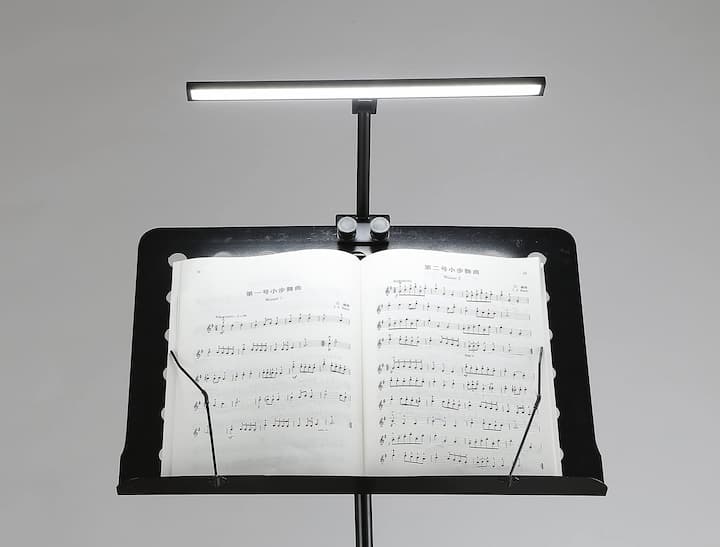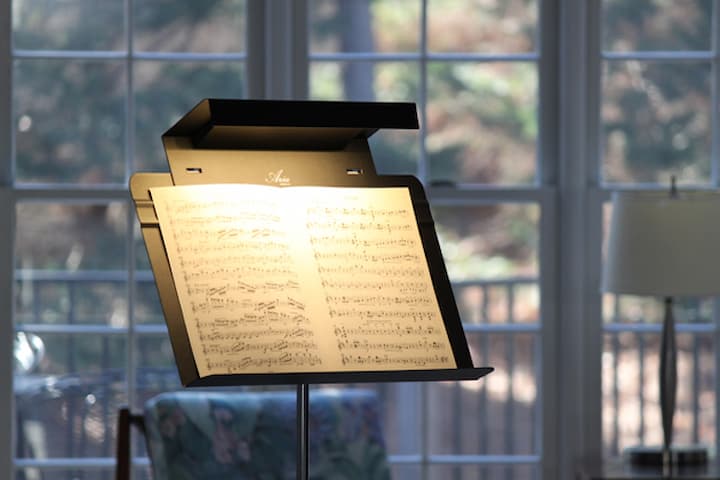A Guide to Music Stand Lights: Illuminate Sheet Music in Style
Sooner or later, every musician finds out how important lighting is when playing music. Therefore, all of them end up looking for lights for stands. Orchestra musicians frequently use them to illuminate their sheet music, particularly while performing in a dimly lit space.
The majority of these specialised designs of lights, if not all of them, have LEDs installed, giving artists brilliant, effective lighting on their stands. Currently, most devices available on the market can cast evenly and shadow-free light for every note on every page.
What to Look for in Music Stand Lights?

All in all, the key is to illuminate sheet music with a high-quality and aesthetically pleasing music stand light from top-selling brands. Nowadays there is a wide selection of stand lights, so finding the ideal type is not always a straightforward decision, especially for novices. The following guidelines might give you a hand in making the best buying decision.
Physical Features
Lights for music stands come with some physical characteristics that shouldn’t be overlooked when making the right choice. The size, weight, clip type, flexibility, and sturdiness all matter when looking for the ideal type. Most likely, weight and size are not very important factors, as most stand lights are lightweight and reasonably small.
If you know it will be difficult to carry a light that won’t fit in your tote bag or instrument box, size should be taken into account. However, bear in mind that the smaller and lighter it is the less brightness you will receive from it. The neck of a stand light should be flexible enough to allow for appropriate positioning, yet solid enough to ensure that the light stays in place once it is in position. This is perhaps the most crucial physical feature.
A neck that’s too flexible can droop under the weight of the light throughout the performance. And it will be an awful experience to keep pushing it back up every few minutes. When it comes to the last physical feature, the clip, the only thing to pay attention to is whether it will clip to the type of stand you have. When narrowing down your choices look for one that supports the whole light while being on a small surface area. The enormous stand lights designed to attach to a metal stand with a strong back frequently malfunction on the wireframe stands.
Light Characteristics
One of the first things you should think about when selecting a music stand light is brightness. More light is required, particularly while performing in a dimly lit space. Make sure the music light you choose emits enough light at the appropriate levels. Excessive lighting would only cause distractions. Additionally, take into account the product’s quality.
A few uses of some music stands lights may cause the illumination to fade due to flimsy construction. Even though today stands lights are mostly LED, the light bulb type is another important consideration when making a brightness choice. However, when utilizing stand lights keep in mind that if you’re using certain types of really white paper, too bright of a stand light can reflect the brightness, making it hard to read the notes.
Battery-Powered
These days, you should purchase a battery-operated stand light to avoid having cords all over the stage, which can cause trips and falls. A battery is also useful for elimination of the need to locate an outlet. Certain lights for stands are rechargeable, some require no external power source to operate, while others use odd batteries or AAA batteries. Ideally, to avoid wasting money on batteries, you should purchase a music stand light that is rechargeable.
Price
In terms of price, more expensive options typically have stronger construction and superior illumination. Since many of them include rechargeable batteries, you may be able to utilize these music stands lights even when they aren’t plugged in. It is important to remember, though, that with the advent of contemporary LED music stand lights, even low-cost alternatives can now provide brilliant illumination that can be useful, particularly during performances.
Best Lights to Have on Your Radar

Now that you know what to look for in stand lights, it’s time to consider some of the best models on the market. Again, the final choice depends upon your needs and preferences, your budget as well as the light’s appropriateness in the orchestra, and its suitability for the musician’s choice.
V.A. YHX-906 Clip-On LED: Best Overall
Whether playing drums, strings or winds, the V.A. YHX-906 is one of the most serious stand lights in terms of performance, practicality and compatibility. It is an excellent set of flexible lights to take with you to orchestral practice or a gig where the lighting is a bit dim. Every light contains two tiny LED bulbs. Each head has a brightness control that allows you to turn on one or both lights. The set includes two AAA batteries and is USB rechargeable.
V.A. YHX-1068 Clip-On LED: Best Versatility
Another great light source for sheet music is the V.A. YHX 1068. It is an excellent music light that you can use at home or bring to orchestra rehearsal. With nine tiny LED lights and two brightness settings, this set may be bent into any desired shape because of its extreme flexibility. It uses either a USB charging cable (about one metre in length) or batteries. The batteries and the charging wire are both included in the package.
Vekkia Professional Musician Piano Light: Best Range of Options
The Vekkia Professional Musician Piano Light comes with three colour temperatures: mixed, white, and warm. This light is lightweight, convenient to use, and portable. You may adjust your light pattern to the desired colour and brightness. Because a steady light source implies light that doesn’t dazzle or flicker, most musicians choose full-on light. Thanks to 19 LED beads, the result is achieving broader field of illumination.







![AFX Sauber F1 C44 Stake No24 Slot Car [22092]](https://www.availableonline.com.au/wp-content/uploads/2025/06/6ccd9e30-c6fa-4910-9081-5fcc3ba80b04__60843-520x245.jpg)
